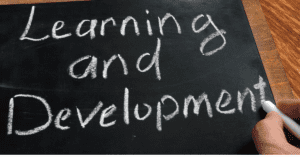Learning and development budgets are coming to their year-end for most companies. As we approach Q4, many executives scramble to invest their remaining L & D dollars. They’re looking for the perfect programming to help their leaders and teams be more successful, not waste their time, and have an impact. But here’s the kicker: most learning and development (L&D) programs are set up to fail. That’s right—despite the good intentions behind them, many don’t have the desired impact and ultimately end up being a waste of (valuable) time. I’m here to tell you why.
My name is Tara Lee, and I own NexLevel. We are dedicated to removing roadblocks to team success and giving leaders time to lead. We work hard to ensure the money and time organizations invest in developing their people don’t go to waste. Unfortunately, in many cases, it does. Let’s dig into why this happens and how we can work together to change it.
Why do so Many Learning and Development Programs Fail?
It’s shocking how much time, energy, and money is wasted on leadership and development programs that deliver little to no return on investment. It’s not that the content or facilitation is poor, but they miss the mark in some crucial areas.
Let’s explore the most common reasons these programs fail.
There’s No Clear Connection to Business Goals
One of the organizations’ most prominent mistakes with their Learning and Development programs is not setting them up to directly impact the company’s strategic objectives. If your L&D efforts aren’t tied directly to business goals, they will lose relevance quickly. Employees are busy. They won’t engage with it meaningfully if they can’t see how the sessions relate directly to their day-to-day responsibilities and the company’s overall direction.
All leadership development initiatives should be directly tied to measurable business outcomes, whether improving productivity, driving innovation, or increasing revenue. If there’s no apparent connection to the goals that matter, employees will see the program as just another task to complete rather than an opportunity to grow and contribute to the company’s success.
Lack of Leadership Buy-In
Employees won’t take it seriously if senior leaders don’t fully support the learning and development program. Leadership buy-in is critical for the success of any learning initiative. When executives don’t actively champion the program or fail to participate themselves, it sends the message that L&D is a “nice-to-have” rather than a critical component of the business.
Employees must see that leadership values the program enough to dedicate their time to it. This means leaders must endorse the initiative and actively participate in it. When top leaders model the behaviours and skills being taught, it creates a culture of continuous learning and development from the top down.
One-Size-Fits-All Doesn’t Work
Another common pitfall of many of these programs is the cookie-cutter approach. Every employee is unique, with different needs, objectives, and challenges. Yet, many programs fail to account for these differences and attempt to train everyone using the same methods and content. This simply doesn’t work.
A one-size-fits-all approach ignores that different roles, departments, and individuals require tailored solutions. What works for the marketing team may not work for sales or IT. Similarly, a seasoned manager will need different development than a new leader just stepping into a management role. Customization is critical if you want to see actual results.
There’s Little Focus on the Application of Learning
Learning new concepts is one thing—applying them in the real world is another. Many learning and development programs fail because they focus too heavily on theory and not enough on how to apply what they have learned in day-to-day work. Change is hard. Even the most well-intentioned employees struggle to alter their behaviours over the long term.
It’s not their fault—it’s human nature. We revert to old habits unless given the tools and support to make new ones stick. Too many programs deliver great content but fail to reinforce it with practical, ongoing applications. Without follow-up or support for implementing new skills, employees will fall back into their comfort zones, and the L&D program will have little lasting impact.
Good News – You Can Have a Successful Learning & Development Program
Thank goodness it doesn’t have to be this way. With the right approach, your program can deliver meaningful impact AND a solid return on investment. At NexLevel, we’ve seen firsthand what works and what doesn’t. I think it’s time consultants are held accountable for delivering the promised results!
Here are the four key elements that will set your program up for success:
Make It Relevant
If you want your employees to engage with the program, it has to matter to them. They must know the answer to “What’s in it for me?” This means aligning the content with your company’s strategic goals and ensuring that employees can see their effort’s direct impact on their daily work. When the connection between L&D and business outcomes is clear, engagement skyrockets, and you’ll see real improvements in behaviour.
Personalize the Program
A one-size-fits-all program won’t cut it. A Discovery phase is required to ensure you understand the gap between the status quo and the desired day-to-day behaviours. You are wasting your time without identifying the specific competencies that need to be developed. Just because the content is good doesn’t mean it’s the right content to meet the unique needs of your teams and employees—the more customized the experience, the better the results.
Back It with Leadership Support
Senior leaders need to walk the talk. When leadership is actively involved in the entire program—from co-creating outcomes in discovery to actively participating in the sessions to modelling the behaviours post-session—it sends a powerful message. Employees will take the program more seriously, and a culture of continuous learning will be much more likely to develop.
Focus on Application and Habit Formation
It’s not enough for employees to learn new concepts; they need to apply them consistently. Ensure your Learning and Development program includes ample opportunity to explore practical applications and a system to support the development of new habits. This can be through habit-builder technology, coaching, peer-to-peer accountability groups, or regular check-ins. The goal is to ensure that new skills and behaviours stay at the top of people’s minds and are embedded daily.
Elevate your Success in Q4
At NexLevel, we are transforming leadership and team development by elevating behaviour, not ticking boxes. We support leaders in removing roadblocks, allowing their teams to thrive, and giving them time to focus on achieving their goals.
Leaders don’t have time for another program that will not have meaningful ROI. We believe it’s time for L&D consultants to be accountable for delivering relevant, personalized outcomes that are supported by leadership and reinforced through action.
As we head into Q4 of 2024, if you are looking to elevate the success of your leaders in a meaningful and measurable way, let’s connect. I’d love to show you how your investment will directly influence your critical strategic goals.
NexLevel is Transforming Leadership & Team Development.
We work with leaders looking to overcome the frustration of recurring team challenges and refocus on strategic organizational goals. We bridge this gap with ease, efficiency, and certainty through a proven process of sustainable behaviour change and measurable impact.





